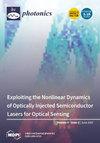等离子体处理对热陶瓷靶溅射制备的厚氧化锌薄膜的发光和闪烁特性的影响
IF 2.1
4区 物理与天体物理
Q2 OPTICS
引用次数: 0
摘要
本文介绍了磁控溅射法制备ZnO厚膜的结构、相组成、形貌、光学、发光和闪烁特性的综合研究结果。利用热陶瓷靶,实现了厚度超过100µm的ZnO微膜的极快生长(~50µm/h),这为闪烁探测器的工业化生产提供了优势。研究了低温等离子体中后处理对薄膜生长的影响,薄膜的晶体质量和光学质量得到了显著改善。结果表明,薄膜在近紫外区表现出强烈的近带边缘发光,衰减时间为550 nm,黄绿色发光主要来自于薄膜的主体部分。本文章由计算机程序翻译,如有差异,请以英文原文为准。
Effect of Plasma Treatment on the Luminescent and Scintillation Properties of Thick ZnO Films Fabricated by Sputtering of a Hot Ceramic Target
The paper presents the results of a comprehensive study of the structural-phase composition, morphology, optical, luminescent, and scintillation characteristics of thick ZnO films fabricated by magnetron sputtering. By using a hot ceramic target, extremely rapid growth (~50 µm/h) of ZnO microfilms more than 100 µm thick was performed, which is an advantage for the industrial production of scintillation detectors. The effects of post-growth treatment of the fabricated films in low-temperature plasma were studied and a significant improvement in their crystalline and optical quality was shown. As a result, the films exhibit intense near-band-edge luminescence in the near-UV region with a decay time of <1 ns. Plasma treatment also allowed to significantly weaken the visible defect luminescence excited in the near-surface regions of the films. A study of the luminescence mechanisms in the synthesized films revealed that their near-band-edge emission at room temperature is formed by phonon replicas of free exciton recombination emission. Particularly, the first phonon replica plays the main role in the case of optical excitation, while upon X-ray excitation, the second phonon replica dominates. It was also shown that the green band peaking at ~510 nm (2.43 eV) is due to surface emission centers, while longer wavelength (>550 nm) green-yellow emission originates mainly from bulk parts of the films.
求助全文
通过发布文献求助,成功后即可免费获取论文全文。
去求助
来源期刊

Photonics
Physics and Astronomy-Instrumentation
CiteScore
2.60
自引率
20.80%
发文量
817
审稿时长
8 weeks
期刊介绍:
Photonics (ISSN 2304-6732) aims at a fast turn around time for peer-reviewing manuscripts and producing accepted articles. The online-only and open access nature of the journal will allow for a speedy and wide circulation of your research as well as review articles. We aim at establishing Photonics as a leading venue for publishing high impact fundamental research but also applications of optics and photonics. The journal particularly welcomes both theoretical (simulation) and experimental research. Our aim is to encourage scientists to publish their experimental and theoretical results in as much detail as possible. There is no restriction on the length of the papers. The full experimental details must be provided so that the results can be reproduced. Electronic files and software regarding the full details of the calculation and experimental procedure, if unable to be published in a normal way, can be deposited as supplementary material.
 求助内容:
求助内容: 应助结果提醒方式:
应助结果提醒方式:


